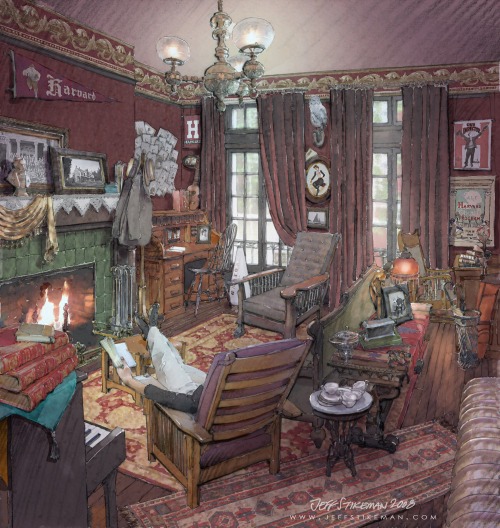
The FDR Suite, Adams House, Harvard; all rights Reserved, jeff stikeman architectural art
Everything old is new again. With the economy as it is, a new administration hinting at sweeping social and banking reforms, and a new, charismatic President who is either beloved or bemoaned, the parallels to FDR and the ’30s and ’40s are obvious. Suddenly FDR is back in the public consciousness.
This image is a conjectural reconstruction of the interior of Franklin Delano Roosevelt’s Suite in Adam’s House, at Harvard. Harvard, whose alumni for years had openly referred to FDR as a “traitor to his class”, is perhaps ready to acknowledge the fact that the man, who some consider the greatest President after Lincoln, was a student of the institution. There is no memorial to Roosevelt at Harvard. The goal of the FDR Suite organization is to rectify that.
From 1900 to the end of 1904, FDR rented the suite of rooms with Lathrop Brown, a Groton School pal. The two moved into what were, at the time, luxurious and ultra-modern rooms. Central heating and private indoor bath facilities were rather new, as was the combination gas and electric lighting. Fourteen foot ceilings, a fireplace, a rented piano, furnishings shipped from Hyde Park augmented by textiles and furniture from Filene’s…. All of it creating a suite of rooms, in 600 square feet, that would boggle the mind of any college freshman today, Harvard or other. This suite is to be restored and, more interesting, furnished and fitted out to give modern day viewers an understanding of the manner in which a wealthy aristocratic student, transitioning between the Victorian age and into the early 1900’s, would have lived.
Precious little associated with FDR’s time in the room exists today. Behind an existing radiator, there is a single old layer of burgundy wallpaper on bare plaster. The wood work is there, and so is, in wonderfully quotidian fashion, the toilet with high water closet, and the marble sink stand. The floor is lighter, having been refinished many times, but it’s likely the original. The original finishes may be gone, but in all respects, the bones are still there.
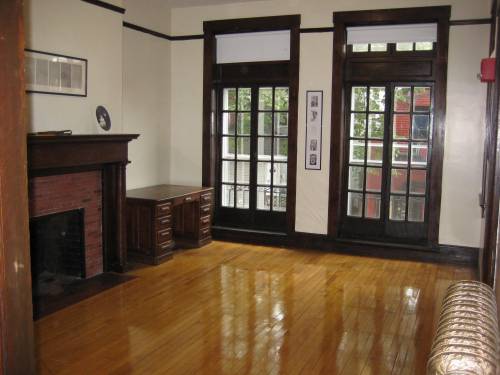
Existing State of the FDR Suite. Image Courtesy of Michael Weishan
I was charged by Michael Weishan, ’86, with pulling together the very little known information about the suite and FDR’s life at the time, and reconstructing a conjectural view of the space. Doris Kearns Goodwin, the presidential historian and Pulitzer-winning author, is an advisor to the project.
Michael is a frequent NPR guest, and the former host of PBS’s “The Victory Garden”. His infectious enthusiasm, and promotion of the project, is the galvanizing force behind the work. In developing the work, we discussed many arcane points, back and forth, in an effort to bring the image to life. Typically, an interior illustration like this comes about with very specific information from a designer or architect. Sofas, fabrics, fixtures… everything is usually spelled out in advance, and the charge is to show it all, compose a tidy illustration, and lay it bare for a client to see. In this case, the effort was to read through FDR’s letters home, to research his time at Harvard, to pore over the web for glimpses into his personal life, and to glean from all that elements that were either known to have existed in the space, those that were very likely to have existed, and those elements that were part of any similar space at the time.
We know from his letters home to Sara (his mother) that there were two Morris chairs, numerous carpets, a (rented) piano, and a small table between the windows at the far end of the image. Beyond that, we know what the rooms would have looked like in a general sense from period photographs of the other rooms of Westmorly Court (as Adam’s House was then known). These “Gold Coast” apartments were inhabited by other wealthy aristocratic students, among them, Astors and Morgans.
Michael and I debated quite a bit the virtues of clutter in the image. To our modern eye, the image is crammed with objects, and uncomposed. In truth, we probably still left out about half of what one might expect to see. In the archival photographs, every surface of these rooms seems to be filled with photographs, lithographs (Gibson Girls an underlying theme in almost all the rooms), pillows, carpets on carpets with runners on top. Heavy velvet drapes, mantle scarves, frames overlapping frames, and table top clutter.

Archive Photograph of a Typical Contemporary Suite; Photo Courtesy Michael Weishan
An early sketchy composition study was done, before diving in to the final image. It was done in a simpler less cluttered manner, with bolder color contrast, to confirm the view, establish a tone, and begin a conversation about what the image “wanted to be”.
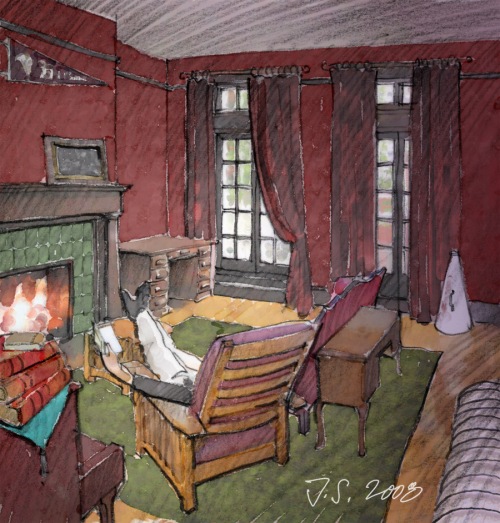
Early Composition Study for the FDR Suite; all rights reserved, jeff stikeman architectural art
After a quick conversation with the client to confirm the direction it was headed, it was further developed into a stripped-down version of what we ultimately were headed for. Prior to producing the final image, a penultimate version was needed in the interim. The client needed to pass along an illustration to be included as part of a small article about the project in the Harvard Crimson, but we wouldn’t have time to finish the fully realized version in time. The composition test and the interim draft gave us a good head start though, and started the conversation. Some tweaks were made, objects added, and the final disposition of the furniture and major elements was settled on. Because the image was going to be so small, and there was so much red in the image, we dropped in a complimentary green rug to take the edge off all the red. In reality, it’s doubtful the rug would have been a monolithic green, but it helps graphically balance yhings in a relatively small illustration.
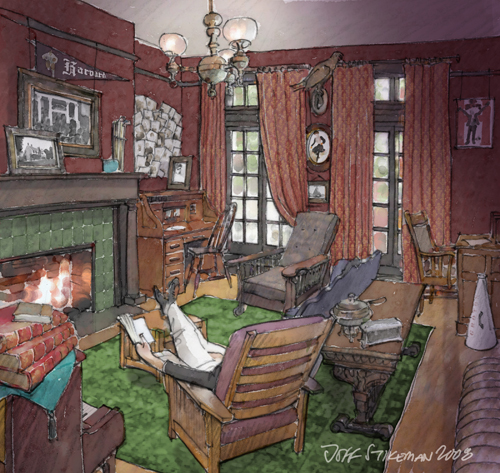
3x3 inch Interim Version, for use in a "Harvard Crimson" article
One thing became obvious from the archival photographs; the rooms were dimly lit, with electric lighting in its infancy and gas struggling to push back the dark. Most lighting was from daylighting through windows. Even during the day, the interior was darker than we are used to. Fabrics were heavy and layered. Rugs, too, with mantle scarves and runners on tables.
But we worried that too much staging would feel over-the-top and that people viewing it in today’s context would think the jumble of objects and darkness were a contrived nostalgia. Too little, and we’d be accused of tidying things up for the modern sensibilities. Michael was a fan of the idea that we assault the senses, but with veracity. Nothing in the image went in without serious consideration. At times, such an approach can stifle the idea. In this case, it was very much like archaeology, however, and layers upon layers of things literal and figural seemed to only make things better.
One example of many: Pipes. A simple suggestion from Michael “let’s not forget to include some pipes” (see the archival apartment photo above, where there is a scattering of pipes on the table). Well, hold on now. Just because there are pipes in ONE photograph from a similar room in the building… isn’t that a bit of a stretch? Well, no. A loose pile of pipes appears in almost every photo from the archive. And we know that FDR was a smoker at the time and later; the iconic image of his jutting jaw and jaunty cigarette holder is among the more famous images of the man. Even so, in simply trying to find out what kind of pipes to show, I ran into some interesting information. The pipes we show were just coming into fashion. Any wealthy fashionable young man would have had a few at least. But it turns out he’d have also had on hand the older, less fashionable (but still in-use) longer clay pipes, too. Cigarettes, which were just becoming popular due to the mass-production of machine rolling (and FDR was an “early adopter”) were the new thing. So we see a jumble of pipes on the table at right, a silver cigarette box near the pipes, and a pair of older fragile clay pipes in their proper pipe stand on the mantle, out of harm’s way. No fashionable wealthy student at the time would have been without any of them.
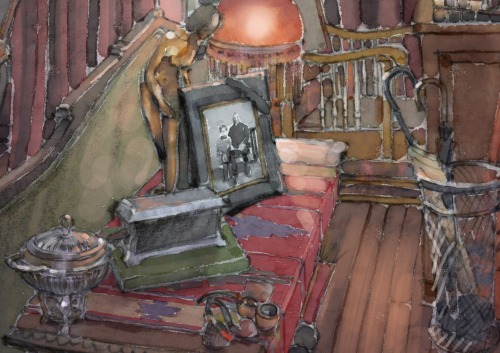
Detail of the Table at right; All rights Reserved, jeff stikeman architectural art
There are numerous “easter eggs” tucked into the image: a framed portrait of Eleanor on FDR’s desk, sitting in the corner; a photo of his “Boston Knockabout’ sailboat; one of his Groton School graduating class; and one of him as a boy sitting on his father’s lap (the black ribbon on the corner of the frame memorializes his father’s death). The table behind the sofa was developed from some photographs of a table purportedly owned by FDR at the time and fairly likely to have been in the room. The FDR Suite organization is considering acquiring the table for use in furnishing the restored suite. A taxidermy owl (up high between the windows) wasn’t anything unusual at the time. We’d originally started with a hawk, but it didn’t feel right. For one, it was also reddish, and dark, and was subsumed into the wallpaper. FDR was wise (perhaps ‘cunning’ is the word) even in his middle-late twenties. Only later when pressed did he become hawkish. So an owl it is. A number of similar considerations occurred to develop the elements in the illustration.
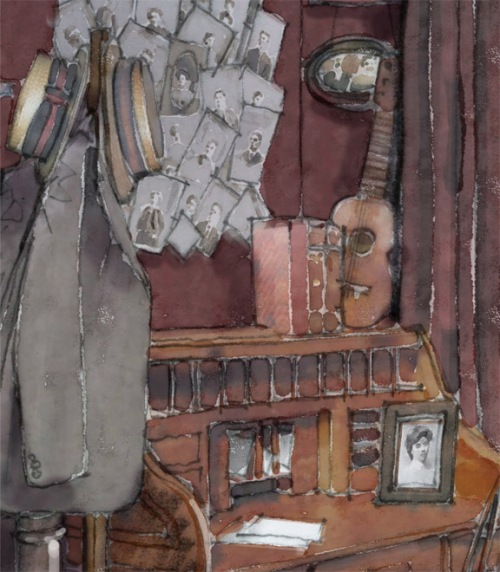
Eleanor, at lower right
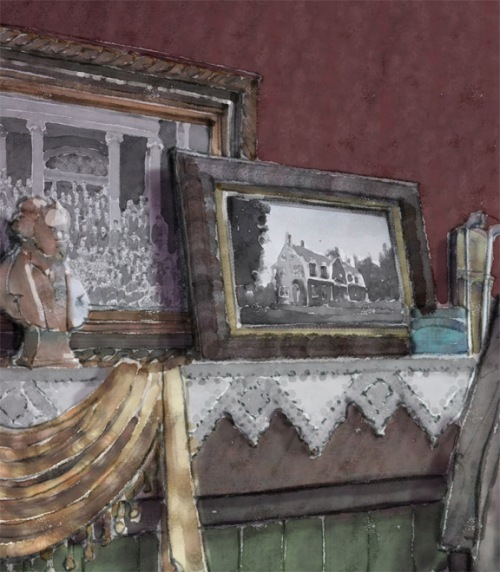
Groton Class Photo (left) and the Roosevelt Summer Home, Campobello (right)
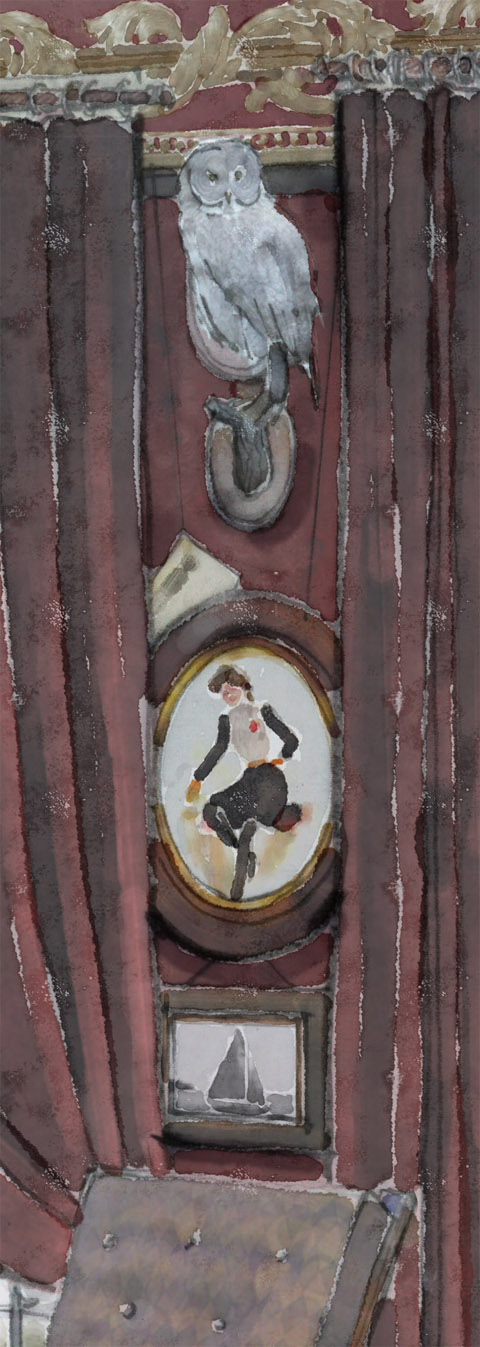
Snowy Owl, Gibson Girl, and the knockabout "Half Moon"
The image was produced in Photoshop, with the work executed on a 21″ Wacom pressure-sensitive monitor. Printed at full 400 dpi resolution, the image is 15″x16″. For me the great joy and challenge of the work was in the research, and in the effort to hold together an assemblage of clutter, to light it in a way that was faithfully dark yet contained color and highlights and contrast, and to create a circular composition which kept the eye moving and searching.
The figure in the chair… I’ve been asked if it is FDR. I can’t answer, really. When I developed the figure, I knew that it was implying the man: undeniably, the arm thrust out very directly, the ease, even the “fireside” nature of it seem to make it obvious. But there was never any danger of seeing his face here. The image is less about him than it is about the room. This is the time just before Roosevelt burst onto the world stage. He’s a student, enjoying his life and wealth, without an aim yet, and with no idea of what lay ahead. He’s a bit more than five years away from his first politically adept moves which masterfully maneuvered the New York State Senate race and brought him to prominence, at least among political peers. But if he had a feeling it was coming, he never let on, not this early anyway. Certainly his fellow students didn’t think so, we know that. Only later, in New York as a young lawyer, did he openly talk about eventually becoming President. We are glimpsing him in the last few moments of his private life, before the world really knew who Franklin Delano Roosevelt was. And so my inclination was to let him be. Hide the face. Let him have some peace for a moment. There’s time enough…
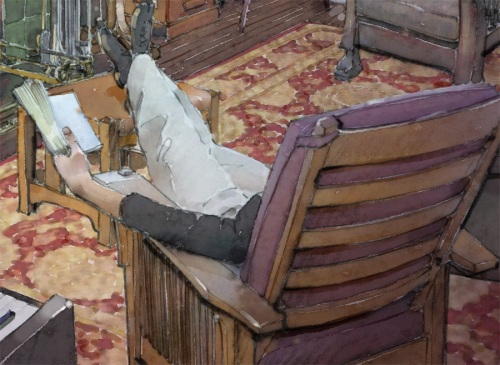
(all rights reserved, jeff stikeman architectural art)
This illustration was selected by a jury for inclusion into the traveling exhibition “Architecture in Perspective 24”. From some 500 entries to the American Society of Architectural Illustrators’ 24th annual juried competition, only 50 or so images were selected to represent the Society’s collective talent. I am honored to once again have a piece in the show.
